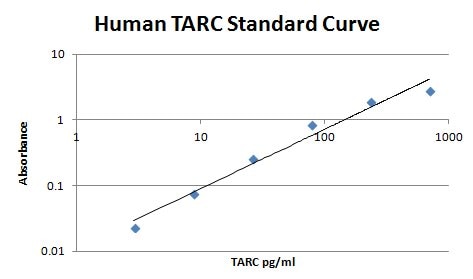Human CCL17/TARC Biotinylated Antibody Summary
Ala24-Ser94
Accession # Q92583
Applications
Human CCL17/TARC Sandwich Immunoassay
Please Note: Optimal dilutions should be determined by each laboratory for each application. General Protocols are available in the Technical Information section on our website.
Reconstitution Calculator
Preparation and Storage
- 12 months from date of receipt, -20 to -70 °C as supplied.
- 1 month, 2 to 8 °C under sterile conditions after reconstitution.
- 6 months, -20 to -70 °C under sterile conditions after reconstitution.
Background: CCL17/TARC
CCL17 is a novel CC chemokine identified using a signal sequence trap method. CCL17 cDNA encodes a highly basic 94 amino acid (aa)residue precursor protein with a 23 aa residue signal peptide that is cleaved to generate the 71 aa residue mature secreted protein. Among CC chemokine family members, CCL17 has approximately 24 - 29% amino acid sequence identity with RANTES, MIP-1 alpha, MIP-1 beta, MCP-1, MCP-2, MCP-3 and I-309. The gene for human CCL17 has been mapped to chromosome 16q13 rather than chromosome 17 where the genes for many human CC chemokines are clustered. CCL17 is constitutively expressed in thymus, and at a lower level in lung, colon, and small intestine. CCL17 is also transiently expressed in stimulated peripheral blood mononuclear cells. Recombinant CCL17 has been shown to be chemotactic for T cell lines but not monocytes or neutrophils. CCL17 was identified to be a specific functional ligand for CCR4, a receptor that is selectively expressed on T cells.
- Imai, T. et al. (1997) J. Biol. Chem. 272:15036.
- Imai, T. et al. (1996) J. Biol. Chem. 271:21514.
- Nomiyama, H. et al. (1997) Genomics 40:211.
Product Datasheets
Citations for Human CCL17/TARC Biotinylated Antibody
R&D Systems personnel manually curate a database that contains references using R&D Systems products. The data collected includes not only links to publications in PubMed, but also provides information about sample types, species, and experimental conditions.
9
Citations: Showing 1 - 9
Filter your results:
Filter by:
-
Sublingual immunotherapy alters salivary IgA and systemic immune mediators in timothy allergic children
Authors: Johanna Huoman, Georgia Papapavlou, Anna Pap, Johan Alm, Lennart J. Nilsson, Maria C. Jenmalm
Pediatric Allergy and Immunology
-
Th1 and Th2 Chemokines, Vaccine-Induced Immunity, and Allergic Disease in Infants After Maternal omega -3 Fatty Acid Supplementation During Pregnancy and Lactation
Authors: Catrin Furuhjelm, Maria C Jenmalm, Karin Fälth-Magnusson, Karel Duchén
Pediatric Research
-
Effect of the topical application of an ethanol extract of quince seeds on the development of atopic dermatitis-like symptoms in NC/Nga mice
Authors: T Kawahara, K Tsutsui, E Nakanishi, T Inoue, Y Hamauzu
BMC Complement Altern Med, 2017-01-31;17(1):80.
Species: Human
Sample Types: Cell Culture Supernates
Applications: ELISA Development -
Lung transplantation affects expression of the chemokine receptor type 4 on specific T cell subsets.
Authors: Paantjens AW, van de Graaf EA, Kwakkel-van Erp JM, Hoefnagel T, van Kessel DA, van den Bosch JM, Otten HG
Clin. Exp. Immunol., 2011-10-01;166(1):103-9.
Species: Human
Sample Types: Serum
Applications: ELISA Development -
Generation of Th1 and Th2 chemokines by human eosinophils: evidence for a critical role of TNF-alpha.
Authors: Liu LY, Bates ME, Jarjour NN, Busse WW, Bertics PJ, Kelly EA
J. Immunol., 2007-10-01;179(7):4840-8.
Species: Human
Sample Types: Cell Culture Supernates
Applications: ELISA Development -
Enhanced generation of helper T type 1 and 2 chemokines in allergen-induced asthma.
Authors: Liu L, Jarjour NN, Busse WW, Kelly EA
Am. J. Respir. Crit. Care Med., 2004-03-04;169(10):1118-24.
Species: Human
Sample Types: BALF
Applications: ELISA Development -
Chemokine receptor CCR4 on CD4+ T cells in juvenile rheumatoid arthritis synovial fluid defines a subset of cells with increased IL-4:IFN-gamma mRNA ratios.
Authors: Thompson SD, Luyrink LK, Graham TB, Tsoras M, Ryan M, Passo MH, Glass DN
J. Immunol., 2001-06-01;166(11):6899-906.
Species: Human
Sample Types: Synovial Fluid
Applications: ELISA Development -
Placental immune response to apple allergen in allergic mothers
Authors: Martina Sandberg Abelius, Uta Enke, Frauke Varosi, Heike Hoyer, Ekkehard Schleussner, Maria C. Jenmalm et al.
Journal of Reproductive Immunology
-
A Th1/Th2-associated chemokine imbalance during infancy in children developing eczema, wheeze and sensitization
Authors: T. R. Abrahamsson, M. Sandberg Abelius, A. Forsberg, B. Björkstén, M. C. Jenmalm
Clinical & Experimental Allergy
FAQs
No product specific FAQs exist for this product, however you may
View all Antibody FAQsReviews for Human CCL17/TARC Biotinylated Antibody
Average Rating: 5 (Based on 1 Review)
Have you used Human CCL17/TARC Biotinylated Antibody?
Submit a review and receive an Amazon gift card.
$25/€18/£15/$25CAN/¥75 Yuan/¥2500 Yen for a review with an image
$10/€7/£6/$10 CAD/¥70 Yuan/¥1110 Yen for a review without an image
Filter by:




